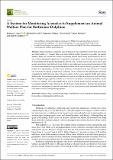Files in this item
A system for monitoring acoustics to supplement an animal welfare plan for Bottlenose dolphins
Item metadata
| dc.contributor.author | Jones, Brittany L. | |
| dc.contributor.author | Oswald, Michael | |
| dc.contributor.author | Tufano, Samantha | |
| dc.contributor.author | Baird, Mark | |
| dc.contributor.author | Mulsow, Jason | |
| dc.contributor.author | Ridgway, Sam H. | |
| dc.date.accessioned | 2021-05-12T12:30:10Z | |
| dc.date.available | 2021-05-12T12:30:10Z | |
| dc.date.issued | 2021-04-29 | |
| dc.identifier | 274064897 | |
| dc.identifier | 3c6b0085-cee5-4d55-8891-fcad8b69c59a | |
| dc.identifier | 85133523093 | |
| dc.identifier.citation | Jones , B L , Oswald , M , Tufano , S , Baird , M , Mulsow , J & Ridgway , S H 2021 , ' A system for monitoring acoustics to supplement an animal welfare plan for Bottlenose dolphins ' , Journal of Zoological and Botanical Gardens , vol. 2 , no. 2 , pp. 222-233 . https://doi.org/10.3390/jzbg2020015 | en |
| dc.identifier.other | Jisc: a86ba8d341094f809f5762e627869380 | |
| dc.identifier.uri | https://hdl.handle.net/10023/23167 | |
| dc.description | The authors are extremely grateful to the Office of Naval Research (ONR) for their support of Sound as Indicators of Health and Welfare of the Navy’s Dolphin; ONR Grant# N00014-18-1-2643. | en |
| dc.description.abstract | Animal sounds are commonly used by humans to infer information about their motivations and their health, yet, acoustic data is an underutilized welfare biomarker especially for aquatic animals. Here, we describe an acoustic monitoring system that is being implemented at the U.S. Navy Marine Mammal Program where dolphins live in groups in ocean enclosures in San Diego Bay. A four-element bottom mounted hydrophone array is used to continuously record, detect and localize acoustic detections from this focal group. Software provides users an automated comparison of the current acoustic behavior to group historical data which can be used to identify periods of normal, healthy thriving dolphins, and allows rare instances of deviations from typical behavior to stand out. Variations in a group or individual’s call rates can be correlated with independent veterinary examinations and behavioral observations in order to better assess dolphin health and welfare. Additionally, the monitoring system identifies time periods in which a sound source from San Diego Bay is of high-enough amplitude that the received level at our array is considered a potential concern for the focal animals. These time stamps can be used to identify and potentially mitigate exposures to acoustic sources that may otherwise not be obvious to human listeners. We hope this application inspires zoos and aquaria to innovate and create ways to incorporate acoustic information into their own animal welfare management programs. | |
| dc.format.extent | 12 | |
| dc.format.extent | 6314587 | |
| dc.language.iso | eng | |
| dc.relation.ispartof | Journal of Zoological and Botanical Gardens | en |
| dc.subject | Animal welfare | en |
| dc.subject | Acoustic monitoring | en |
| dc.subject | Vocal behavior | en |
| dc.subject | Vocal biomarkers | en |
| dc.subject | Marine mammal | en |
| dc.subject | Bioacoustics | en |
| dc.subject | Communication | en |
| dc.subject | Distress call | en |
| dc.subject | QH301 Biology | en |
| dc.subject | QL Zoology | en |
| dc.subject | NDAS | en |
| dc.subject | SDG 3 - Good Health and Well-being | en |
| dc.subject | SDG 14 - Life Below Water | en |
| dc.subject.lcc | QH301 | en |
| dc.subject.lcc | QL | en |
| dc.title | A system for monitoring acoustics to supplement an animal welfare plan for Bottlenose dolphins | en |
| dc.type | Journal article | en |
| dc.contributor.institution | University of St Andrews. School of Biology | en |
| dc.contributor.institution | University of St Andrews. Scottish Oceans Institute | en |
| dc.contributor.institution | University of St Andrews. Sea Mammal Research Unit | en |
| dc.identifier.doi | https://doi.org/10.3390/jzbg2020015 | |
| dc.description.status | Peer reviewed | en |
This item appears in the following Collection(s)
Items in the St Andrews Research Repository are protected by copyright, with all rights reserved, unless otherwise indicated.

